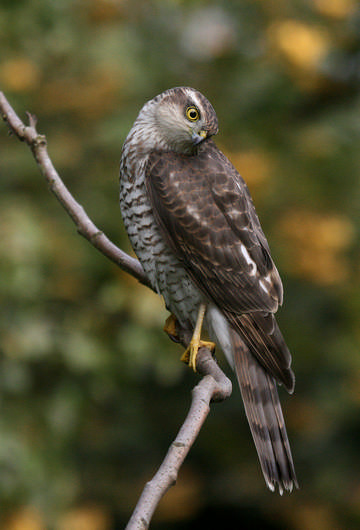
Sparrowhawk © Sheila Blamire
This survey shows that Sparrowhawks are much more widespread than they were twenty years ago, when the species was still recovering from the effects of organochlorine pesticides. In our First Atlas they were found in 382 tetrads, 97 of them with confirmed breeding and 84 with probable breeding; the equivalent figures in this Atlas have risen to 478, 130 and 105. They nest only in trees, especially in the largest available woods, but otherwise they use parks and large gardens as they have spread into the areas of densest human population, including the Mersey Valley and north Wirral, and across much of agricultural southwest Cheshire. The main areas of absence are the treeless areas of the highest land (where they seem to have withdrawn from several tetrads in which they were found in the First Atlas) and the estuarine saltmarsh, along with the Gowy valley and scattered parts of central Cheshire. Although Sparrowhawks always nest in woodland, they often hunt in other areas, and the reported habitat codes reflect this: 49% woodland, nearly all of them broadleaved or mixed, 4% scrub, 31% farmland and 13% human sites.
The size difference between the sexes is greater than in any other raptor, female Sparrowhawks being around twice the weight of males, allowing the pair to exploit a very wide range of prey (Newton 1979). Their diet is exclusively birds, up to their own body weight or even more. Males especially take tits and finches, and species up to the size of Blackbirds. Females can catch much larger prey, tackling anything from Woodpigeons downwards. In the breeding season Sparrowhawks mostly catch fledglings, and they time their own breeding to be later than that of most of the smaller woodland birds, so that maximum numbers of prey are available to feed their own young. They will fly a long way from their nest to find food, typically up to 3-4 km in good habitat and 4-6 km in poorer areas, thus overlapping their hunting range with other Sparrowhawks (Newton 1986). There is inevitably, therefore, a chance that records of birds seen hunting, or carrying food for their young, belong to an adjacent tetrad. Observers found nests in 46 tetrads, with adults carrying food providing the bulk of confirmed breeding records (65), and 19 observations of recently fledged young, chicks spreading out through woodland whilst still obviously showing flecks of down amongst their plumage. In 7 tetrads birds were seen building or visiting a probable nest-site (B or N) and in 8 tetrads surveyors reported the agitated ‘kek-kek-kek’ calls of adults; however, half (51) of the probable breeding records came from fieldworkers seeing display, one or both adults circling on stiff wings high above their territory, with 35 reports of pairs.
The Sparrowhawk population nationally is now about double that at the start of our First Atlas in 1978, but we do not have a good quantitative estimate of the county population because Sparrowhawks are only sporadically recorded on BBS transects. [Nests tend to be regularly spaced in suitable habitat, that spacing varying strongly with altitude, from nests 0.5 km apart at elevations up to 70 m to a separation of 2 km at altitudes above 300 m; the altitude is a proxy for density of suitable prey, but this relationship works remarkably well across the UK.] The hunting range of male birds in the breeding season may be as little as 30 ha, mostly woodland, at low elevations, but more than 250 ha at 200 m altitude (Newton 1986). These figures suggest that a density of 1-2 pairs per tetrad is sustainable in reasonable habitat. With this Atlas survey showing 235 tetrads with confirmed or probable breeding the Cheshire and Wirral population is likely to be in the range 300-400 pairs, more than twice the figure in our First Atlas, but only half the total for Kestrels. The national estimate for the British population is 38,600 pairs of Sparrowhawks, very similar to that for Kestrel (35,400) (Baker et al 2006); Cheshire and Wirral is a less well-wooded county than many, so it is not surprising that our total of breeding Sparrowhawks is lower than that for Kestrels.
Sponsored by James Quinn

